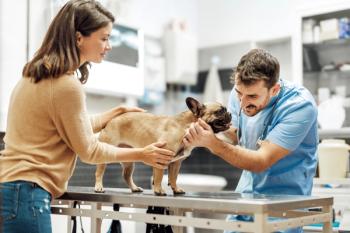
Building client trust component of pet's care
Mrs. Johnson awaits your entrance draping her head over her usually trembling rat terrier named Wiggles.
Mrs. Johnson awaits your entrance draping her head over her usually tremblingrat terrier named Wiggles.
Wiggles is behind on all her vaccinations and heartworm tests and isnot spayed. She also hasn't had a thorough examination in at least threeyears.
Although Mrs. Johnson has been in the clinic with Wiggles for numeroustoenail trims in the past three years, she has always stated that her petwas in fine shape and really didn't think an examination was necessary.When asked about getting her spayed Mrs. Johnson patiently explained tothe assistant that she hadn't had a "period" in several yearsand now was beyond the need for such an 'operation'.
Stressed pooch
The staff really like Wiggles but has always dreaded her visits becauseshe is very stressed by any treatment experience at all. It is also obviousthat Mrs. Johnson is reluctant to let the staff remove Wiggles from hergrasp. Her pet's trembling and reaction to handling has only made Mrs. Johnsonmore protective of any care beyond a nail trim.
This trip was different. While in a protective hug from her owner, Wigglesturned blue and fainted during a nail trim. Mrs. Johnson is now only tooeager for the doctor to examine her pet. When you arrive, Wiggles is recoveringdue to the oxygen your fast-thinking technician has given.
The verdict
Your exam (the medical crisis has made your exam much easier) revealsan advanced cardiopulmonary condition, serious dental disease, mammary tumorsand fleas. After Wiggles has recovered somewhat, you gently tell Mrs. Johnsonthat a work-up is needed including, blood tests, X-rays, ultrasound, ECGand heartworm testing.
Mrs. Johnson becomes frozen in time. Seconds seem to drip along likehumidity in August. She finally informs you that her budget cannot enduresuch an onslaught of tests and trips to the veterinarian. You sense thatsomething else makes her hesitate. She may not be able to trust you.
A reactive client
Mrs. Johnson is what I call a reactive client. While she is resistantto a proactive approach to her dog's health care, which would save her aboatload of time and money, she also secretly does not trust veterinariansor anyone else who would come between her and her pet.
Therefore another problem also exists in that Mrs. Johnson has a co-dependencywith Wiggles that does not allow her to release her pet to others-especiallyinto an environment that would stress her pet. Although she has to be carefulwith her finances, her real problem involves a trust issue and an emotionaldependency to her pet.
Your response is:
a. Give her a quote for all the work and await her response.
b. Offer to do everything for free because of her poverty and that sheis a very nice person.
c. Spend some time talking to her about her dog and her relationshipwith Wiggles and then patiently give her all her options.
d. Refer this patient to a lowcost colleague.
e. Chastise her for her obvious abuse and oversight.
f. The rubber meets the road
The rationale
Choice (a) is tempting in that time is always in short supply at a veterinaryhospital and it is the practical and expedient approach. Unfortunately,this client is likely to be confused and inattentive during a crisis withher pet.
The best answer to this question is (c). Your responsibility now is toengender trust.
This client needs assurances that her pet will be all right and thatyou will do everything to protect her pet. This is a tall order and no guaranteecan be made with regard to treatment outcomes, yet the owner must learnto trust you. Trust takes time, and in the past she has not given you timeto develop a trusting relationship.
Wiggles is sick, and there is not a lot of time available. Can you developan effective bridge of trust for this client? What follows are some pointsof reference.
Client trust is a function of:
Past experiences at previous veterinary offices. This can be a real hurdlefor the current veterinarian to overcome.
It is always wise to investigate past "bad" experiences andperceptions the client holds. Until you resolve past concerns your clientwill withhold trust. Many clients misunderstand explanations made by previousveterinarians, which compounds any issues that conflict with their previousunderstandings.
Prejudices of family and friends. These can work for you or againstyou. Clients hold in high regard the information and dis-information theyreceive from others. This is primarily because they can relate directlyat their level of experience. Your job is to investigate these issues andput certain concerns to rest in non-judgmental ways.
The amount of time you spend explaining all the issues and answers concerninga client's pet. (See sidebar, page 19.)
Staff sensitivity. Staff (past and present) plays an importantrole in how your client will perceive any future care they may receive.Most clients come to veterinarians because of convenience and proximityto their home. Surveys reveal that 65 percent of clients will lose confidenceand switch to other veterinarians because of a perceived attitude of indifferencefrom the staff. This is a training issue.
An unresolved medical/surgical condition. Pets under your care oftendo not respond to therapy in spite of quality animal care. If you are notcommunicating the nature of your therapy and its occasional potential forfailure in spite of excellent therapy plans, you will eventually lose thetrust of your client. A veterinarian must communicate ideas and rationale.In addition, many veterinarians feel that if they refer a case to a specialistthe client may lose confidence in their abilities. A wise veterinarian knowswhen to refer a case to a specialist-to do so actually solidifies trust.
Follow-up. Clients need to know you are thinking about their pets. Whenthey leave their pet in the hands of strangers it can be stressful for them. To gain their trust they need to know that you truly are a friend as wellas a profession. Taking time to update a client with a pet in the hospitalor who has been discharged connects you to them in an environment they know-theirown home. Trust will build quickly when follow-up is a standard protocol.
Dr. Lane is a 1975 veterinary graduate of the University of Illinois.After graduation he practiced as an associate in California before movingto Carbondale, Illinois and establishing Lakeside Veterinary Hospital in1978. Dr. Lane completed a master's degree in agricultural economics in1996. He is the author of numerous practice management and economics articles.
Sidebar: Developing trust through client education
Trust can occur in a number of ways but one of the best ways is toreally become a teacher.
Clients understand little about what is going on in a veterinary hospitalbeyond the fact that their treasured pet is in need of some form of veterinaryattention.
Listening to their concerns and explaining your treatment approach(especially visually) is very much appreciated.
The time spent doing this creates a trust relationship what will smooththe way for future treatments. Here are some key concepts:
1. Clients usually learn more efficiently when you draw pictures andpresent pictures from books and promotional material from your vendors.
2. Sitting down together in chairs side by side and then presentingmaterial or concepts is often more comfortable for the client.
3. Using staff to hold the pet or taking the pet for a short walkthrough the hospital will help the client focus on your presentation.
4. Talks of this nature should be conversational and never confrontational.
5. Always take a position of understanding the clients' concerns beforegoing forward with anything.
6. A final plan of action is never final until the client receivessomething in writing concerning your approach-even if only on a scratchpad for further review at home.
Newsletter
From exam room tips to practice management insights, get trusted veterinary news delivered straight to your inbox—subscribe to dvm360.






